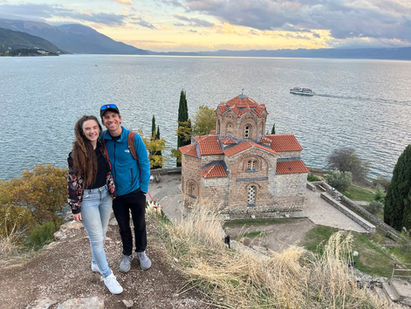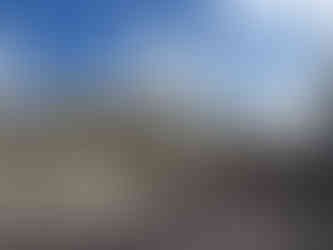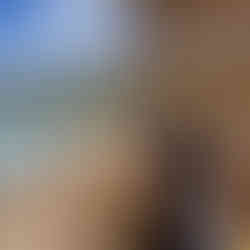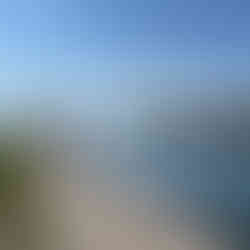



Aug 1512 min read



After a whirlwind few weeks exploring Bulgaria, we were ready to dive headfirst into a country we had barely heard of - North Macedonia. Where’s that, you ask? Tucked in the Balkans, it’s a landlocked gem bordered by Greece, Albania, Kosovo, Serbia, and Bulgaria.

With a population of just over 2 million, it boasts rugged mountains, ancient lakes, and a fascinating mix of history, from Alexander the Great to the breakup of Yugoslavia. But for us, it had one particularly attractive feature - it was outside the European Schengen Zone! That meant we could stretch our 90-day European tourist limit in the continent a little further, while also discovering a brand-new destination! We did the math, and landed on 8 days in this mysterious country.
We had no real idea how long the bus ride from Sofia to Skopje would take, just that we were heading into the unknown. The journey from Bulgaria to North Macedonia was an interesting one. Rolling hills and valleys shrouded in fog gave way to eerie relics of the past - abandoned communist-era factories standing in contrast to the occasional modern looking building. One particularly surprising site was a very-much-active nuclear power plant which boasted some hilarious google reviews.










Leaving Bulgaria meant passing through two border checks. First, the smooth and uneventful exit from the European Union. We hopped off the bus, got our passports stamped, and were on our way. As we waited, we noticed a group of runners arriving at the border, part of something called the Peace Run—a global torch relay promoting unity and peace worldwide. There was even a Kiwi in the group, which was a fun little moment of familiarity in such a random place.






Then, we crossed into North Macedonia, and the atmosphere shifted instantly. The immigration post looked noticeably more run-down—faded signs, cracked pavement, and an air of neglect that made it very clear we had left the European Union. North Macedonia has been trying to join the European Union for years, but political instability, economic struggles, and concerns over corruption have kept it on the waiting list. And the border crossing reflected that reality. The immigration officer barely acknowledged us, a cigarette dangling precariously from his lips as he stamped passports in his tiny, dimly lit booth. He didn’t even glance at our bus, which, as we later learned, was a stroke of luck—another traveler told us their bus had been held up for four extra hours thanks to some “suspicious packages” the company had been caught transporting..
After immersing ourselves in Bulgaria’s history and culture, we were excited to explore this neighbouring country with a shared border yet still had a unique identity. Unlike Bulgaria, North Macedonia was once part of Yugoslavia, shaping its history in a completely different way. It was also officially known as just "Macedonia" until a 2018 agreement with Greece where they conceded to add North to its name—a compromise which we'd later learn was a controversial one. Locals still call it Macedonia, which only added to the complexity and intrigue of the country. With so many differences packed into such a small country, we couldn’t wait to dive in and learn more.
After a quick nap, we arrived in North Macedonia’s capital, Skopje (pronounced Skop-ye). We made our way to our hostel, dropped our bags, and headed out for a quick walk in search of food. Feeling indulgent, we decided to try a highly rated Japanese restaurant. Two out of three dishes were excellent, but the service was so comically bad that it became part of the experience. To top it off, there was a mandatory 10% tip—for the rudeness, apparently. That was enough to convince us to stick to local food for the rest of our stay.






Walking through Skopje’s main square felt like stepping into a bizarre open-air museum. Towering over us were hundreds of statues—massive, dramatic, and seemingly ancient. We assumed they were relics from the communist era, but in reality, they were part of "Skopje 2014", a wildly controversial €500 million government project aimed at giving the city a grand, historic aesthetic. The result? A chaotic mix of weird buildings, oversized monuments, and enough statues—around 150—to make you wonder if the city had an obsession with bronze.










The most striking of them all was the enormous statue of Alexander the Great, a proud memorial to Macedonia’s most famous historical figure. Or at least, that’s who it was clearly meant to be—officially, it was called "Statue of a Warrior on a Horse," a diplomatic workaround to avoid further disagreements with Greece, which also claims Alexander the Great as its own. Greece even has it's own statue of him in their region of Macedonia in Greece. It was all so strange!




To make things even stranger, the city was in the midst of setting up for the Skopje Marathon, happening the next day. Wizz Air—a Hungarian ultra-low-cost airline best known for its budget flights across Europe—also happened to be the title sponsor of this unexpected marathon. The contrast between the oversized statues and the neon pink branding of Wizz Air was surreal. If only we had known earlier—Luke could have signed up for a last-minute entry! Maybe next time.
One thing that stood out to us in Skopje was the sheer number of gambling and betting agencies—they were everywhere. Many of the names were familiar to Luke from a previous job, which made it all the more surprising. We learned that North Macedonia has earned a reputation as a sort of gambling hub in Europe, attracting visitors from nearby countries thanks to its relatively low regulation and widespread corruption in the industry. It was a bit disheartening to see, with countless shops filled with poker tables and slot machines on every corner. In fact, the country has one of the highest numbers of casinos per capita in Europe, and the gambling scene has become an unfortunate focal point for economic activity in some areas.






We made our way to a sunset spot near the old fortress walls of Skopje. The view was definitely worth the trek, but it was hard to ignore the stark contrast between the crumbling, poorly maintained walls and the shiny, over-the-top statues we had seen earlier. It was a real shame, especially considering the fortress's historical significance. From up there, we had an incredible vantage point over various parts of the city, including the Old Bazaar, which we explored next. Crossing the river felt like stepping into another world—like we’d somehow wandered into Turkey or Albania. The vibe was strikingly different, with narrow streets, vibrant markets, and a much more traditional atmosphere compared to the modern city center.










Our hostel owner was a really cool local 27 year old. He first opened the hostel 7 years ago, but during covid, rented it out to a Turkish construction company for workers until just 3 months ago, when he renovated and reopened a hostel just a few weeks before our visit. Business was booming for him, which he wasn’t expecting for the off season. It was interesting to hear his local perspective of life in Macedonia and how he personally believed they will never enter the EU. He also mentioned even he feels like he’s entering Albania or Turkey when crossing the river!
Planning our days in Skopje was tricky with the marathon closing city streets, but we discovered the local bus could still get us to Matka Canyon — one of the most iconic spots just outside the city. It was only 15 km away, but the ride took an hour. At €1.50, it was a classic case of being rich in time, not money, and totally worth it. On the bus we met a Norwegian guy and a Danish girl, and ended up exploring together. We hiked the slightly sketchy canyon path, looking down at kayakers and boat tours below. Rain was on the forecast, but we lucked out with perfect weather.










Our new travel friends were globally minded and knew a lot about history and politics — not just in the Balkans, but in their own countries and the US. The Danish girl had spent a high school exchange semester in a small Oklahoma town, so Jelley swapped stories from her own time in Nebraska, both remembering the warmth and hospitality of the American Midwest. Our Norwegian travel friend also mentioned his excitement with his upcoming plans to travel to the United States during the upcoming Presidential Election.
We said goodbye to our new friends and caught the bus back into Skopje. That night, we stumbled upon a tucked-away local dinner spot buzzing with live music and traditional dancing. The air was thick with cigarette smoke - somehow even heavier than in Bulgaria - curling above tables crowded with laughter and clinking glasses. One woman sat directly behind us, chain-smoking and almost seeming to blow second-hand smoke our way on purpose. The vibe was lively, but the haze made it hard to fully enjoy.
North Macedonian food feels like a close cousin to Greek cuisine: platters of grilled meats (or "kebabs) and shopska salads piled with ripe tomatoes and lots of white cheese. There’s also no shortage of grilled vegetables, doused in olive oil. Fresh bread arrives warm and soft, perfect for tearing apart and dipping into some garlicky sauce or more olive oil. It’s hearty, flavorful, and made for sharing.








The next morning over breakfast we met a Kiwi girl and got chatting about our travels. When we mentioned we’d started in Nepal last year, her eyes lit up — “I’m flying there today!” Such a random coincidence. We shared a few tips and stories, trying not to overwhelm her before her flight. That’s one of the best parts of hostel common areas crossing paths with like-minded people on the same travel trail, either heading where you’ve been or coming from where you’re going. We also met an Aussie guy named Mitch who was a similar age and been travelling for 6 months, mostly in Georgia and Armenia. So neat to hear different travel experiences and destinations.
We joined a small walking tour the next day to peel back Skopje’s layers beyond the statues and bazaar. There were 5 of us in the walking tour and it gave us a deeper understanding of the strange city. It’s often called a "city of contrasts" because so many very different eras, cultures, and styles sit side by side, sometimes literally on the same street. We passed Ottoman mosques, Byzantine fortifications, and socialist-era concrete blocks, then turned a corner and saw grand neoclassical facades built only a decade ago. The city’s story stretches back to the 6th century BC, shaped by Romans, Byzantines, and Ottomans, battered by wars and earthquakes, and rebuilt in wildly different styles each time. And yet, North Macedonia as a modern nation has only existed for just 33 years, gaining independence peacefully in 1991 after the breakup of Yugoslavia.










A third of the country’s population (about 600,000 people) lives in Skopje, yet it still feels like a small capital. A massive 6.1 earthquake in 1963 destroyed 80% of the city, prompting aid from 78 countries, including the USA and USSR cooperating for the first time since WWII. The rebuild gave Skopje its unusual mix of architecture, later amplified by the controversial Skopje 2014 project. Over €560 million was spent on new facades, statues (over 150 of them), and faux-classical buildings. Many of the projects were never finished, and locals were never consulted through a public vote, a source of ongoing frustration.
We also got a glimpse of some of Skopje’s quirks. Casinos along the borders are technically only for foreigners, not locals, with the Flamingo casino being the most luxurious and popular among Greeks. Gambling remains mostly unregulated in North Macedonia, which seems to be a source of much of the countries troubles with corruption.
On our walk, we learned that “Macedonia” means “high” or “mountainous,”and that Mother Teresa was born here in 1910, and that the Ottoman period left lasting cultural footprints, from bustling bazaars to a “sunken church” built lower than the ground to avoid overshadowing a mosque. The city’s diverse population, roughly 65–70% Orthodox Christian and 20–25% Albanian Muslim, reflects centuries of shifting borders, wars, and peace agreements. Skopje felt like an ancient town that has been continually reinvented. A peculiar city rebuilding itself over and over.
The next day we headed to a different part of North Macedonia, Lake Ohrid. It came highly recommended as a favorite spot for some of our friends who described it as their favourite place in the world (after visiting around 60 countries!). Lake Ohrid is located in southwestern North Macedonia, bordering Albania, and is one of Europe’s oldest and deepest lakes. At 34 km long, 300 meters deep, and around 3 million years old, it is also one of the most biodiverse lakes in the world, making it a truly stunning natural wonder. It sounded like a truly special place and we were excited for a few days of peaceful nature and to use it as our base for exploring the area.
We took a shuttle bus from Skopje to Lake Ohrid, a journey about 172 km or 2.5 hours. Our hostel friend Mitch, an Aussie, joined us for the ride as he was heading that way too. The shuttle reeked of oil and gasoline, making it hard to breathe, and the driver chain-smoked cigarettes the entire way. It was a welcome reminder that we were definitely still traveling in Eastern Europe, where things are not always as comfortable. Needless to say, we were happy to finally arrive at Lake Ohrid after a long ride of holding our breath.




We reached our accommodation, a small Airbnb/guesthouse, and were greeted by the cutest old couple. They met us on arrival and welcomed us warmly, showing us around the place. Their English was limited, but they had prepared a little guide with maps, explanations, and even a welcome drink. It was incredibly sweet and felt very personal. The guesthouse was in a more local part of town rather than on the lakefront, which made it very budget-friendly, and it was just a seven-minute walk to the lake.






We followed our host’s recommendation and stopped at a small Turkish sweet shop for some baklava — absolutely delicious. As we wandered through the lake-side town of Ohrid, it was clear that it was off-season. Not everything was open, and there weren’t many people around, which suited us perfectly.
Later, we walked down to the iconic St. John Kaneo church to watch the sunset. The spot was truly spectacular, perched above the lake with incredible views. We made a quiet promise to ourselves to catch the sunset there every evening during our stay in Ohrid.








We stayed in Ohrid for five nights, so there was no rush to cram everything into each day. We also had plenty to do with wedding preparations, planning the final six weeks of our travels, and catching up on this blog. It was the perfect place to settle in for a while. At just €20 per night, and with inflation seemingly not having hit the area yet, we could easily have stayed for two or three weeks.
The next day we explored Ohrid’s Old Town, a charming area of cobbled streets, traditional houses, and historic churches that has been a center of culture for centuries. We tried to visit the old Fortress, but it had closed at 3 pm. We still managed to catch the sunset, though it wasn’t quite as spectacular as the night before.








The following day we took a short taxi ride down the coast of Lake Ohrid to St. Naum, just 1 km (about 0.6 miles) from the Albanian border. This area is famous for its peaceful monastery, crystal-clear springs, and rich biodiversity. It’s a popular beach in summer, but when we arrived, only a few brave souls were swimming. We visited the monastery and took a short boat ride on the St. Naum spring, which stays a constant 12 degrees Celsius (54 degrees Fahrenheit) and reaches 3.5 meters (about 11.5 feet) at its deepest point. The lake is fed by numerous underwater springs, creating crystal-clear water with bubbles from oxygen released by the 28 plant species below, three of which are endemic. It was spectacularly peaceful. Tiny, fully grown ducks darted underwater, unable to fly but excellent divers. The whole spot felt incredibly serene.


















We had a lovely lunch right on the water next to the spring and enjoyed watching a floating pontoon with people singing and dancing to Macedonian music. Even a few little old ladies at a distant table were singing along. It was delightful.






Back in Ohrid, we finally made it up to the fortress, known as the Ohrid Fortress or "Samuel’s Fortress". Originally built in the 4th century BC and expanded during the Byzantine and medieval periods, it served as a defensive stronghold for the region and later became the seat of Tsar Samuel of the First Bulgarian Empire in the 10th century. Walking along its ancient walls offered great views over the town, the lake, and the surrounding mountains.








As we headed back to our accommodation, our lovely hosts welcomed us in and invited us to share in some schnapps and stories. Their English was limited, but from what we could gather, they were originally from Serbia and had lived in Ohrid for several years. They shared broken stories about the 'good old days of Yugoslavia' and what it was like to live through its collapse. It was fascinating to hear their perspective on a time so different from today. They had two sons. One had moved to Hong Kong and the other still lived with them in Ohrid. Coincidentally, he came home while we were there, spoke excellent English, and took great pride in sharing his geographical knowledge, pointing out where New Zealand and various U.S. states were. We decided to call it a night once our male host had one too many schnapps and started telling us what great guys certain controversial world leaders were, which made for a memorable end to the evening.




The next day we headed to Struga, a charming town at the northern end of Lake Ohrid. We took the bus, which, like before, reeked of diesel and made us question whether any vehicle or road standards existed in North Macedonia. Despite the smoky ride, Struga was well worth it. The town was darling, and the water was crystal clear, flowing from the lake into a canal in a way that felt almost magical. We wandered along the lakeside, enjoying a leisurely walk, and eventually found a cute little pizza place for lunch. The weather was perfect, and the day felt like an ideal little date.












We watched our final sunset over Lake Ohrid, bittersweet, but a reminder that it was time to move on. Our paths were about to split for a short while. While in Ohrid, Luke received notification that he needed to visit an approved biometrics center as part of a visa application for another country. Conveniently, the nearest location was in Tirana, Albania, just three hours away by bus. Jelley would continue on our originally planned route, heading back to Skopje for the night and then on to Thessaloniki, Greece, where Luke would join a couple of days later.




It has felt like a blast from the past revisiting these photos and stories 10 months later.. and we can't wait to get caught up on 2024's adventures and bring this blog back to the present day!
Until Then,

- A Kiwi and A Cali











I missed this!!!! - Vivid storytelling, as always. Can't wait to relive all of this when you guys publish your adventures into a book. - Gannon